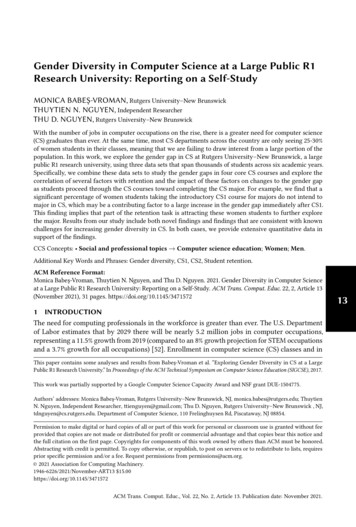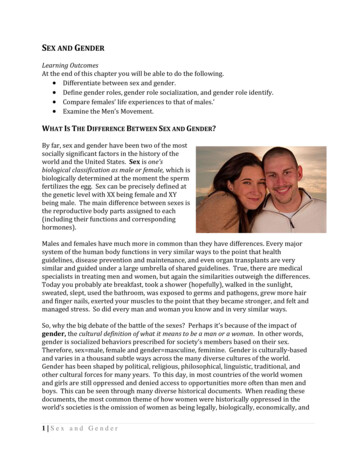
Transcription
Gender Diversity in Computer Science at a Large Public R1Research University: Reporting on a Self-StudyMONICA BABEŞ-VROMAN, Rutgers University–New BrunswickTHUYTIEN N. NGUYEN, Independent ResearcherTHU D. NGUYEN, Rutgers University–New BrunswickWith the number of jobs in computer occupations on the rise, there is a greater need for computer science(CS) graduates than ever. At the same time, most CS departments across the country are only seeing 25-30%of women students in their classes, meaning that we are failing to draw interest from a large portion of thepopulation. In this work, we explore the gender gap in CS at Rutgers University–New Brunswick, a largepublic R1 research university, using three data sets that span thousands of students across six academic years.Specifically, we combine these data sets to study the gender gaps in four core CS courses and explore thecorrelation of several factors with retention and the impact of these factors on changes to the gender gapas students proceed through the CS courses toward completing the CS major. For example, we find that asignificant percentage of women students taking the introductory CS1 course for majors do not intend tomajor in CS, which may be a contributing factor to a large increase in the gender gap immediately after CS1.This finding implies that part of the retention task is attracting these women students to further explorethe major. Results from our study include both novel findings and findings that are consistent with knownchallenges for increasing gender diversity in CS. In both cases, we provide extensive quantitative data insupport of the findings.CCS Concepts: Social and professional topics Computer science education; Women; Men.Additional Key Words and Phrases: Gender diversity, CS1, CS2, Student retention.ACM Reference Format:Monica Babeş-Vroman, Thuytien N. Nguyen, and Thu D. Nguyen. 2021. Gender Diversity in Computer Scienceat a Large Public R1 Research University: Reporting on a Self-Study. ACM Trans. Comput. Educ. 22, 2, Article 13(November 2021), 31 pages. https://doi.org/10.1145/34715721INTRODUCTIONThe need for computing professionals in the workforce is greater than ever. The U.S. Departmentof Labor estimates that by 2029 there will be nearly 5.2 million jobs in computer occupations,representing a 11.5% growth from 2019 (compared to an 8% growth projection for STEM occupationsand a 3.7% growth for all occupations) [52]. Enrollment in computer science (CS) classes and inThis paper contains some analyses and results from Babeş-Vroman et al. “Exploring Gender Diversity in CS at a LargePublic R1 Research University.” In Proceedings of the ACM Technical Symposium on Computer Science Education (SIGCSE), 2017.This work was partially supported by a Google Computer Science Capacity Award and NSF grant DUE-1504775.Authors’ addresses: Monica Babeş-Vroman, Rutgers University–New Brunswick, NJ, monica.babes@rutgers.edu; ThuytienN. Nguyen, Independent Researcher, ttienguyen@gmail.com; Thu D. Nguyen, Rutgers University–New Brunswick , NJ,tdnguyen@cs.rutgers.edu. Department of Computer Science, 110 Frelinghuysen Rd, Piscataway, NJ 08854.Permission to make digital or hard copies of all or part of this work for personal or classroom use is granted without feeprovided that copies are not made or distributed for profit or commercial advantage and that copies bear this notice andthe full citation on the first page. Copyrights for components of this work owned by others than ACM must be honored.Abstracting with credit is permitted. To copy otherwise, or republish, to post on servers or to redistribute to lists, requiresprior specific permission and/or a fee. Request permissions from permissions@acm.org. 2021 Association for Computing Machinery.1946-6226/2021/November-ART13 15.00https://doi.org/10.1145/3471572ACM Trans. Comput. Educ., Vol. 22, No. 2, Article 13. Publication date: November 2021.13
13:2M. Vroman, T. N. Nguyen, and T. D. Nguyenthe CS major has increased rapidly in the past decade in response to this need. Yet, progress inreducing the gender gap in CS programs has been slow. For example, the percentage of womenearning a bachelor’s degree in computer and information sciences (CIS) has only increased fromabout 17% in 2011/2012 to 21% in 2018/19 [14]. (The number of women earning degrees in CIShas increased significantly, but only at a slightly higher rate than the number of men earningdegrees in CIS.) Further increasing the number of women with degrees in computing is critical inproviding the needed workforce, and, at the same time, increasing diversity, which is crucial in thecreation of technology [31]. Environments that are diverse perform better, have more innovationand productivity, and have a more supportive infrastructure [5].The gender gaps in many college STEM majors have been extensively studied [39]. Sax haspointed out that it is important to study each discipline separately [40], rather than looking atall STEM disciplines together as in previous work [39], since root causes of gender gaps can bedifferent in various disciplines. Multiple studies have looked at the gender gap in CS [2, 31, 48].In this work, we add to this body of knowledge using extensive data sets from a large public R1research university.Specifically, in this paper, we analyze student data from a set of four core courses, CS1 throughCS4, that all majors in our undergraduate CS program are required to take. Our data comprisesthree different data sets: one data set contains demographic data, course information, and grades;the second one comes from an introductory survey our CS1 students take and contains informationabout each student’s computing background and how likely they are to pursue the CS major (amongother information); the third data set comes from an exit survey, asking CS1 students, among otherinformation, what is their level of agreement with three statements revealing their attitudes towardCS. We describe these data sets in more detail in Section 3.Using the above data sets, in Section 4, we first explore questions such as whether or not there isa gender gap in CS at our university, how the gender gap has changed over the last several years,how it changes from introductory courses to advanced courses in the major, and whether there aredifferences between the two main categories of students, those entering the university as freshmenstudents and those entering as transfer students. Then, in Section 5, we explore the correlationbetween student retention and four factors: intent to major, prior experience, students’ attitudesand confidence, and grades. As we present quantitative data, we carefully reflect on implicationsfor efforts targeted at increasing gender diversity in CS.A main contribution of our work is the combining of three complementary data sets withextensive amounts of longitudinal data to answer a number of questions about our CS studentbody that, as far as we know, have not been answered before. For example, we give concrete dataon where along a path of four required courses women decide to leave the CS major, and showthe retention rates for women and men students who take the CS1 course intending to major inCS compared to those not intending to major in CS. Some results match current knowledge andaccepted wisdom, but we provide concrete numbers from a large CS program.We believe that this data and the accompanying analyses are valuable because large departmentsat institutions similar to ours generate a considerable percentage of the computing workforce inthe country. Further, this paper presents a self-study and assessment that stretches over a numberof years. The results are partially informing a comprehensive initiative to increase diversity, equityand inclusion (DEI) in the CS major. We summarize our findings and their implications in Section 6,briefly discuss a lesson learned, and briefly describe some of the efforts in our initiative. We hopethat the data reported in this paper, our findings, and our approach to the self-study are useful topeers at institutions pursuing the same goal of increasing DEI in CS.ACM Trans. Comput. Educ., Vol. 22, No. 2, Article 13. Publication date: November 2021.
Gender Diversity in CS213:3BACKGROUND AND RELATED WORKA number of studies have looked at enrollment data on computing students and some analyzedgender differences in enrollment numbers and pass and fail rates in CS classes [2, 46, 48, 53]. Ourwork integrates data on enrollments, grades, and surveys to answer questions about intent to major,prior experience, attitudes, and grades, and their correlations with actual retention rates. Otherrelated papers report on survey data [11, 17, 41] or on data from interviews [16, 21, 31] and assessthe students’ sense of belonging, students’ attitudes, motivations, and confidence in computing.We use both surveys and enrollment data to correlate our observations on gender differences withgrades and retention.One paper analyzed the students’ grades on seven projects in an introductory programmingcourse [38] and fitted these grades to a mixture model with two Gaussian distributions. While thiswork also analyzed student data, it was mainly focused on students’ grades and the analysis didnot include any other student information.A few other papers have analyzed student data with the goal of understanding phenomena suchas gender gaps in college courses. The Freshman Survey [22] provided one of the largest suchdatabases. This data has been extensively analyzed and used to answer questions on how men andwomen attending college are different in terms of background, achievement, perceptions of theirenvironment, etc [39]. Our work focuses on gender differences in computer science specifically.Previous work has also addressed the issue of low female representation in STEM disciplines[41, 45], looking at educational factors that influence this phenomenon and making suggestions onhow to change this trend. In computer science specifically, many have asked the question why arethere so few women majors [6, 9, 11, 16, 21, 31] and strategies to close the gender gap have beenproposed [2, 10, 17, 18, 23, 27, 33, 35, 42, 43], including addressing the attitudes of students towardcomputer science [1, 7, 30, 37, 41, 49]. Our work does not directly address the reasons behind lowfemale representation in CS, but rather uses extensive student data to explore the gender gap andcorrelations between several factors and student retention.Our work explores differences in gender diversity and retention between students entering ouruniversity as freshmen and transfer students. Previous work has described the experiences oftransfer students transitioning to 4-year institutions, including their academic and social adjustment [28]. The experiences and unique challenges of women of color in STEM transferring from acommunity college to a 4-year institution were also discussed [34]. Another study [24] examinescommunity college pathways to computer science degrees earned at 4-year institutions and explainsthe challenges, especially for women and underrepresented minorities, of transferring from thesupportive environment in community colleges to the competitive setting that characterizes 4-yearinstitutions. Such competition can trigger stereotype threat and lower the students’ confidencein their ability to succeed in the field. They also show that only 12% of CS bachelor’s recipientsare female compared to 50% of other STEM graduates. The lower representation of women cancontribute to a decrease in the women’s feelings of belonging to CS. Our work complementsthese previous studies by providing quantitative data and correlation between several factors andretention.Research in the retention of women students in the computer science major lacks a consistenttheoretical framework [32]. While a few theoretical models exist, they either are not widely usedor they do not account for differences in the experiences of men and women students [32, 47].Stephenson et al. [46] have reported retention rates in some CS undergraduate programs in theUS. They note that “. retention . is difficult to define and isn’t used consistently across institutionsor conversations.” Indeed, differences between the data sets that they studied and ours lead todifferences in our abilities to quantify retention, making it difficult to compare findings. Nevertheless,ACM Trans. Comput. Educ., Vol. 22, No. 2, Article 13. Publication date: November 2021.
13:4M. Vroman, T. N. Nguyen, and T. D. Nguyenwe discuss some high-level similarities and differences in findings in Section 4.3. Stephenson etal. also wrote, “additional research is needed to provide a more nuanced understanding of thedynamics of attrition and retention, to identify the factors that decrease retention .”. Our workadds to this needed body of knowledge.A number of computing departments at North American universities have made it their goal toincrease the percentage of women in their classrooms. Some of their initiatives included changingtheir CS1 classes to contain more real-life applications [20, 26], offering learning opportunities tostudents who did not have prior experience [13, 26], providing research projects for undergraduatefemale students [13, 26], building a solid community of women in computing [26, 31], engagingfaculty in recruitment [13] and training them on how to design engaging classes [20], increasingthe diversity of the faculty [13], and reaching out to middle schools and high-schools [13, 20]. Ourdata and analyses may aid these and other universities and colleges in their efforts to narrow thegender gap in CS.3RESEARCH CONTEXT, DATA SETS, AND METHODOLOGYThis research was conducted at Rutgers University–New Brunswick, a large public R1 researchuniversity, located in New Jersey, United States. Our student body comprises over 50,000 studentsfrom all 50 states and more than 100 countries, is approximately equally divided between women andmen students, and is highly diverse with respect to race, ethnicity, and socioeconomic background.Rutgers–New Brunswick offers at least several computing-related majors, including ComputerScience (CS), Electrical and Computer Engineering, Information Technology and Informatics,Business Analytics and Information Technology, and Management Information Systems. In thisstudy, we explore the gender gap in four CS courses offered by the CS Department in the School ofArts and Sciences (SAS). Undergraduate students are admitted into schools within the university.Admitted students enter SAS without declaring a major, although they may indicate specific interests.Then, students generally declare a major as soon as they have met admission requirements formajors, usually by the end of their second year. Students may adjust their declared major ormajors at any time until their final semester. Students in our school can also earn minors. The CSdepartment offers programs leading to bachelor degrees (B.S. and B.A.) and a CS minor. Studentsentering schools other than SAS may also take courses in SAS and graduate with majors and minorsfrom our school in addition to majors and minors from their enrolling schools.The four courses we study broadly cover foundational CS concepts, including Introduction toComputer Science (CS1), Data Structures (CS2), Computer Architecture (CS3), and Algorithms(CS4). All four are required for the undergraduate CS major, and only CS1 and CS2 are required fora CS minor (although CS3 is needed for a significant fraction of the pathways toward earning a CSminor).The first three courses, CS1, CS2, and CS3, form a direct sequence, with CS3 requiring CS2 as aprerequisite, and CS2 requiring CS1. The fourth course, CS4, requires CS2 as a prerequisite but notCS3, and so may not always be taken after CS3. However, it is the highest level course requiredfor the major and the majority of our students delay taking CS4 until after CS3 (often by severalsemesters). Thus, the students’ progression through this sequence of courses is very indicativeof their progression through the major. Most students taking and passing CS4 end up earning abachelor’s degree in CS. In this study, we equate students’ taking CS4 with their declaration of aCS major. This approach more accurately captures students working toward CS bachelor’s degreesthan counting declared majors since a fraction of students do not formally declare their major untilthey are ready to graduate.Our CS department values diversity and has been intentionally working to promote diversity,equity, and inclusion (DEI) in our undergraduate student body for several years with strongACM Trans. Comput. Educ., Vol. 22, No. 2, Article 13. Publication date: November 2021.
Gender Diversity in CS13:5support from the school and university. Our expanding and ongoing effort includes outreach tomiddle schools, high schools, and community colleges,1 curricular reforms [12], and co-curricularprogramming [51], all guided by data-informed reflections on student experiences and outcomes[4] (and this work). Our DEI efforts involve collaborations with partners throughout Rutgers–NewBrunswick and a range of statewide and nationwide partners (for example, BRAID at AnitaB.org).We refer the interested reader to the departmental Broadening Participation in Computing (BPC)Plan verified and available on BPCnet.org.2We use the terms “women students” and “men students” to denote categories of self-identifiedgender (female and male) in our data sets. Students can also decline to provide gender informationor self-identify as “other” (than male or female), but the fraction of such students is very small and,therefore, we do not include them in our analyses.Our study uses three data sets. All data sets are anonymized, but entries are linked between datasets by anonymized student ids.The first data set contains all students who have enrolled in CS classes from Summer 2014through Spring 2020, with student demographics (for example, gender), admission categories (forexample, entering the university as a freshman or as a transfer student), and grades. We call thisdata set the Registrar data. It allows us to longitudinally observe students taking the sequence offour courses as they make their way through the CS major.The second data set, the Introductory Survey, contains responses to optional surveys taken atthe beginning of CS1 for the following semesters: Fall 2015, Spring and Fall 2016, and Spring andFall 2017. As we explain below, for consistency within the data set3 and across several analyses, welimit the use of this data set to survey answers gathered during four semesters: Fall 2015, Spring2016, Fall 2016, and Spring 2017. Among other information, each survey asks students about theirtentative or declared major and what kind of prior experience in CS they have. The set of studentstaking these surveys is a strict subset of the students in the Registrar data.The third data set, the Exit Survey, comes from an optional survey taken at the end of CS1 duringevery Fall and Spring semester between Fall 2015 and Fall 2017. Again, as we explain below, we onlyuse survey answers from Fall 2016 and Spring 2017. Among other information, each survey asksstudents about their attitude toward CS, the frequency with which they used available resourcessuch as tutoring, and how helpful they found these resources to be. Many of these survey questionswere designed to collect information that is outside the scope of this study. The set of studentstaking these surveys is also a strict subset of the students in the Registrar data.The above data sets complement each other to give a more comprehensive picture of who ourstudents are, what are their backgrounds, what are their interests in the CS major, what classesthey take, and the grades they earn. When analyzing our data, we typically group pairs of Fall andSpring semesters into academic years (AYs) as the characteristics of the populations of studentsdiffer somewhat between Fall and Spring. For example, enrollment in CS1 is always significantlyhigher in the Fall, and typically a greater fraction of the students in the Fall intends to pursue theCS major than in the Spring. An AY contains the Fall semester from the previous calendar year andthe Spring semester of that year. For example, AY 2015 contains Fall 2014 and Spring 2015.We typically do not consider Summer course offerings because the vast majority of our studentstake classes during the Fall and Spring semesters, and the Summer offerings are substantiallydifferent than the normal Fall and Spring offerings.1 Someexamples: https://www.rutgerscshub.com/ and ool-computer-science.2 URL for PDF: Q k-DR3 pZ5g9I-/view.3 The introductory survey evolved over time.ACM Trans. Comput. Educ., Vol. 22, No. 2, Article 13. Publication date: November 2021.
13:6M. Vroman, T. N. Nguyen, and T. D. NguyenFig. 1. Percent of women students in CS1 throughCS4 over time.Fig. 2. Percent of women students in CS1 through CS4for cumulative enrollment across AYs 2015-2020.We use the 𝜒 2 (chi-square) test with a significance level (𝛼) of 0.05 to determine the statisticalsignificance of differences between groups in a number of analyses in the paper. When discussingthe statistical significance of changes in percentages, for example, the percentages of womenstudents enrolled in a course over time, we are using the 𝜒 2 test on the actual counts behind thepercentages. We explicitly mention when differences are statistically significant or not statisticallysignificant. When the numbers in a group are too low for 𝜒 2 , we use Fisher’s exact test instead.44.1GENDER GAPS AND RETENTIONOverall Gender GapsWe begin our study by assessing the gender gaps in CS1 through CS4. Using the Registrar data,Figure 1 shows the percentages of women students in the four courses for AYs 2015 through 2020,and Figure 2 shows the percentages of women students in the four courses when enrollment isaccumulated over all 6 AYs. The total number of students enrolled in the courses over all AYs are:9,193 in CS1, 6,620 in CS2, 3,968 in CS3, and 3,375 in CS4. Since we are only studying students whoidentify as women and men, the percent of women students and the percent of men students addup to 100%.Clearly, there are significant gender gaps that are similar to national averages [14]. The differencesin the percentages of women students taking CS1 over the six AYs are statistically significant. Weobserve, however, that the percent of women students in CS1 increased from 2015 to 2017, butthen essentially “flattened” out from 2017 through 2020. We can see the increase in the percentageof women students in CS1 reflected later in time in all three of CS2, CS3, and CS4, although thedifferences across the six AYs are statistically significant only for CS1 and CS3. We also see theflattening or a slight decrease reflected in CS2 and CS3, and expect to see the same trend in thenear future in CS4.The gender gap increases steadily as our students progress toward completing the CS major.In particular, the percentage of women students starts at 26.6% in CS1 and decreases to 17.2% inCS4, with the largest decrease occurring between CS1 and CS2 (a drop of 5.7% from 26.6% to 20.9%).The differences in percentages of women students for cumulative enrollment in the four courses(Figure 2) are statistically significant.Consistent with previous research [14], the number of women students studying CS has increasedsignificantly from AY 2015 to AY 2020. However, the number of men studying CS has also increasedsignificantly, so that the overall gender gap has decreased slowly; in fact, in our case, the narrowingof the gender gap seems to have stalled between AY 2017 and AY 2020.ACM Trans. Comput. Educ., Vol. 22, No. 2, Article 13. Publication date: November 2021.
Gender Diversity in CS13:7Fig. 3. Percentages of students from threecategories in CS1 - CS4. NM nonmatriculated, EF entering as freshmen,T transfer.4.2Fig. 4. Percent of women entering as freshmen (EF) andtransfer (T) students in CS1 - CS4.Gender Gaps for Students Entering as Freshmen and for Transfer StudentsOur courses enroll three main categories of students: students entering the university as freshmen(“entering as freshmen (EF)”), students transferring to the university with at least 12 college credits(“transfer (T)”), and non-matriculated (NM) students. In the remainder of the paper, the termentering as freshmen refers to the entering status of the students, rather than their current year inthe program when they enroll in a specific class. For example, an entering as freshman studentinterested in the CS major will typically take CS3 in their sophomore year and CS4 in their junioror senior year.Figure 3 shows the breakdown of the cumulative enrollments (AYs 2015 through 2020) for CS1through CS4 for the three categories of students. Figure 4 shows the percentages of women studentsin CS1 through CS4 for students entering as freshmen and for transfer students.4 These figuresshow that the percentage of transfer students increases from CS1 to CS4, rising above 25% for CS4,and that the gender gaps are larger for transfer students than for students entering as freshmen in allfour courses. In addition, the difference between the percentages of women transfer students andstudents entering as freshmen is increasing from CS1 to CS4, and the differences are statisticallysignificant. Our findings for CS1 and CS2 are consistent with data reported for first-year and transferstudents in a case study from the University of California, San Diego [46]. Overall, the findingsindicate the importance of working with institutions that our transfer students are transferringfrom to recruit more women students to explore the CS major, and to ensure well aligned pathwaysthat support and allow transfer students to successfully complete the CS major at our university.4.3RetentionWe now explore how the retention of our students affects the gender gaps shown above. In particular,we look at retention rates for the three two-course sequences CS1 to CS2, CS2 to CS3, and CS3to CS4, where retention rate is defined as the percent of students enrolling in the first course thatgo on to take the second course. In each case, we look at the students enrolling in the first courseduring AY 2016 and AY 2017 and compute the fraction that go on to take the second course inany semester from Fall 2016 through Spring 2020, including summer. We limit the time period forstudents taking the first course to AY 2016 and AY 2017 because (i) it gives the students time totake the second course, and (ii) the time period coincides with the survey data we use below toexplore the correlation between some factors and student retention. We consider pairs of courses4 Wedo not show percentages for non-matriculated students because they comprise only small percentages of the overallenrollments.ACM Trans. Comput. Educ., Vol. 22, No. 2, Article 13. Publication date: November 2021.
13:8M. Vroman, T. N. Nguyen, and T. D. NguyenFig. 5. Retention rates.Fig. 6. Retention rates for women entering as freshmen (W EF), menentering as freshmen (M EF), women transfer (W T), and men transfer(M T) students.as opposed to the entire sequence from CS1 through CS4 because the latter approach would ignorestudents starting later in the sequence, for example, a transfer student who has taken CS1 elsewhereand enters our course sequence by taking CS2. Finally, we only consider students entering asfreshmen and transfer students since non-matriculated students are typically not working towarda CS degree.Figure 5 shows the retention rates for the three two-course sequences, and Figure 6 shows theretention rates broken up by categories of students and gender. During AYs 2016 and 2017, 2,591unique students took CS1, with 26.4% women students; 1,783 students took CS2, with 19.3% womenstudents; and 1,030 students took CS3, with 15.8% women students.Our data shows that significant fractions of students stop exploring or pursuing the CS majorafter CS1 and CS2. (Students not going on to take CS2 have also stopped exploring or pursuing aCS minor.) On the other hand, a large fraction (80%) of the students who take CS3 go on to takeCS4 (and, as discussed above in Section 3, most will complete the CS major). The differences inthe retention rates between the groups shown in Figure 6 for the three sequences are statisticallysignificant.The retention rates for women students are lower than those for men students with the exceptionof the retention of transfer students from CS3 to CS4. Retention is especially poor from CS1 to CS2for women transfer students, with a statistically significant difference between the retention ratesof women entering as freshmen and of women transfer students. Interestingly, the retention ratesfor women transfer students rise above those for women students entering as freshmen for CS2to CS3 and CS3 to CS4. The retention rate for men transfer students is also below that for menstudents entering as freshmen for CS1 to CS2, although the difference is not statistically significant,and is comparable for CS2 to CS3 and CS3 to CS4. These findings point to the possible challengesthat transfer students face when they must start with CS1 on arrival to our university. In the nearfuture, we will seek to understand why so many transfer students need to take CS1, and why suchlarge fractions of these students, especially of women students, do not continue on to CS2.While the retention rates from CS2 to CS3 and CS3 to CS4 are slightly higher for women transferstudents than for women students entering as freshmen, combining these data with the resultsshown in Figure 4 tells us that proportionally more men transfer students are arri
13 Gender Diversity in Computer Science at a Large Public R1 Research University: Reporting on a Self-Study MONICA BABEŞ-VROMAN, Rutgers University-New Brunswick THUYTIEN N. NGUYEN, Independent Researcher THU D. NGUYEN, Rutgers University-New Brunswick With the number of jobs in computer occupations on the rise, there is a greater need for computer science










